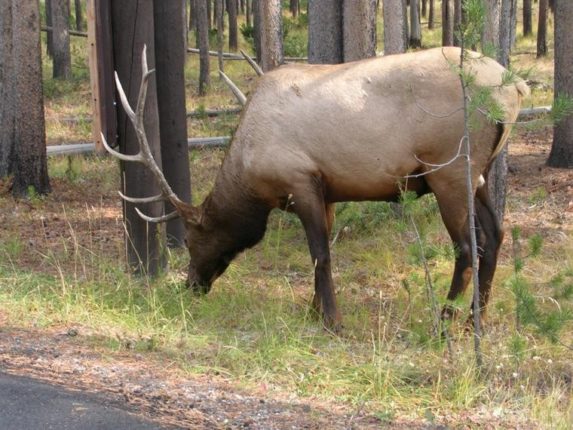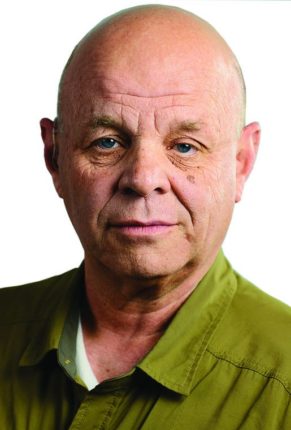The other day I was looking at posts on face book when one caught my eye. A woman who owns a restaurant in a Northwestern state put up a sign in her business window with a picture of an AR-15 explaining that anyone who owned one of these rifles was not…
Author: By Smokey Merkley
Guide to the lower loop of Yellowstone
When my wife and I visit Yellowstone National Park, we like to spend a couple of days exploring the upper loop of the park as I described last week, and a couple of days exploring the lower loop of the park. The lower loop or southern part of the park is that portion of the park from Canyon Village to the south entrance to the park. It also includes the area from the Madison Junction to Old Faithful and over the Continental divide and on down to Yellowstone Lake and on to the east entrance to the park.
We usually set up camp in the Madison campground because my wife likes the running water at each camp spot and the indoor, modern, bathroom facilities. We also like to return to the camp ground around 5 p.m. to cook dinner and see the elk come down to the meadows along the Madison River and listen to them bugle.
We try to have breakfast and then leave the campground early in the morning, turn right at the junction and drive the short distance to Fire Hole Canyon Drive to see Fire Hole Falls. After leaving Fire Hole Canyon, we drive south along the Fire Hole River past Fountain Flats to the Lower Geyser Basin.
The Lower Geyser Basin is impressive, and well worth taking 30 minutes to and hour to walk around the area. Just be sure to stay on the boardwalk path the park has built around the area.
About a mile south of the Lower Geyser Basin parking lot is the turnoff to Fire Hole Lake Drive. This is one of least known attractions in the park and yet one of the most beautiful and scenic spots. Fire Hole Lake should be on everyone’s list of things to see in the park.
Continuing south along the Fire Hole River, the road goes through the Midway Geyser Basin and Biscuit Basin where Chief Joseph of the Nez Perce lead his people through the park on their way to Montana and Canada.
Farther south is the upper Geyser Basin with several trails lasting from 1 to 2 miles around the upper basin area with views across the basin from the tops of the mountains around the area.
A mile farther down the road is Old Faithful, the most famous geyser in the park. The geyser goes off approximately every 45 minutes to an hour and is spectacular. There are cabins, showers, a hotel, medical facilities, a gas station and a couple of restaurants at Old Faithful. There are also numerous trails around Old Faithful and the other geysers in the area, which are also active. There are hiking trails all through the mountains around the Old Faithful area.
About 17 miles east of Old faithful is Craig Pass on the Continental Divide at 8,262 feet above sea level. There is a trail from Craig Pass down to Shoshone Lake.
About another 17 miles east of Craig Pass is the West Thumb of Yellowstone Lake, and the West Thumb Geyser Basin.
Turning north at West Thumb the road follows Yellowstone Lake approximately 40 miles to Bridge Bay, a boat harbor and campground where boat trips around Yellowstone Lake can be arranged.
The campground at Bridge Bay is really nice and often frequented by bison who camp there also. Just remember that bison don’t want to be your friends, so don’t antagonize them and you should be all right.
Lake is about 8 miles up the road from Bridge Bay and has a store, a lodge, cabins, a hotel, hospital, two restaurants and a post office.
Fishing Bridge is just a mile or so northeast of Lake and has a store, a hard-sided campground, a visitor center and a museum.
Following the road from Fishing Bridge north, one can view LeHardys Rapids and Sulfur Cauldron.
Sixteen miles northwest of Sulfur Cauldron is the Hayden Valley. Bison, bears, wolves, pelicans swans and many variety of ducks and other birds can be seen in the Hayden Valley.
At the top of the lower loop and across from Canyon Village, is the Grand Canyon of the Yellowstone, possibly the greatest attraction in the park. It certainly attracts artists and photographers.
From Canyon, my wife and I head for the Norris junction, turn left drive down through Gibbon Meadows, past Gibbon Falls and back to the Madison Campground to have dinner and wait for the elk to come down to the meadow along the Madison River and bugle late into the night.
Smokey Merkley was raised in Idaho and has been hunting since he was 10 years old. He was a member of the faculty of Texas A&M University for 25 years. There he taught orienteering, marksmanship, self-defense, fencing, scuba diving and boxing.
He was among the first DPS-certified Texas Concealed Handgun Instructors. He can be contacted at mokeydo41245@hotmail.com.
Guide to the upper loop of Yellowstone
This is the time of year my wife and I make reservations to spend three or four days at Yellowstone National Park during the spring, summer and fall. The campgrounds and cabins in Yellowstone park are usually full, so it is wise to reserve your campgro…
At least I saw a moose
This past deer season found my son and I showing a couple of my nephews an area we like to hunt. We tried to show them where the biggest bucks in the area like to hang out and the trails they use to move through the area.
Once the nephews had returned to Idaho Falls and my son had to get back to his job in another state, I ended up giving the same tour of the area to a friend who lives closer to the area than I do.
Finally, I found myself hunting the area alone, so I got up early and was waiting about 150 yards above a well-used game trail that at least one of the larger bucks in the area uses to come down off the mountain to feed and get water every couple of days.
I had chosen this particular location because the exit trail the deer take in this area when spooked, such as a high-powered rifle going off close by, is also visible from my location, although it is about 300 yards away.
I was there early and figured I had about two hours before finding out if I had picked the right game trail and would harvest a buck just as he came up a steep incline and turned right to continue up to the top of the ridge. With my binoculars I was able to see fresh tracks and scat the day before, so I was hopeful I was in the right place.
The temperature while I was waiting in the dark was in the high twenties. When 8 a.m. arrived, it was still in the mid-30s. So I figured that I might have to wait until 10 a.m. for the deer to move enough to use the game trail I was watching. At 10 a.m. the temperature was in the lower 50s, but had only been so for half an hour. I decided to wait a bit longer.
When 11 a.m. rolled around and I hadn’t seen any deer, I decided that this was not my day on this game trail. At 11:05 a.m. several high-powered rifle shots broke the silence from up above the ridge.
I decided to wait a little while longer to see if any bucks would use the trail I was sitting above or the exit trail I had seen them use in the past to leave the area on the ridge.
I had learned from my father and uncles as a young boy that rifle fire from other hunters will usually send bucks to their area escape routes. If I am sitting close to one of those hard-to-find escape routes, those other hunters may do me the favor of pushing bucks to me.
An hour later and still no bucks sighted, I moved to an area my son and I call “The Tunnel” to see if I would have better luck there, and to eat a sandwich while watching the area.
By 6 p.m. I was home without having seen anything except a bull moose in the deep scrub. However, I didn’t have a moose tag so I only got to look at him until he decided to go further into the scrub where I couldn’t see him any more.
I usually hunt three different areas for a few days each October. But I decided to hunt just one of them every day this year with the exception of a dental appointment one day. It turns out that was a mistake, and I probably would have seen more bucks if I had stuck to hunting all three areas for a few days during the season.
The good news is that there may be some additional opportunities for hunting this year if I want to go into Northern Idaho. I’m not sure I will do that this year unless my son can get away from work for a few days. I will be thinking about it for next year though.
If you are interested in the hunting opportunities in Idaho for the rest of the year, get a current Big Game rules book from Fish and Game and see if any of the hunts fits your schedule.
Smokey Merkley was raised in Idaho and has been hunting since he was 10 years old. He was a member of the faculty of Texas A&M University for 25 years. There he taught orienteering, marksmanship, self-defense, fencing, scuba diving and boxing. He was among the first DPS-certified Texas Concealed Handgun Instructors. He can be contacted at mokeydo41245@hotmail.com.


